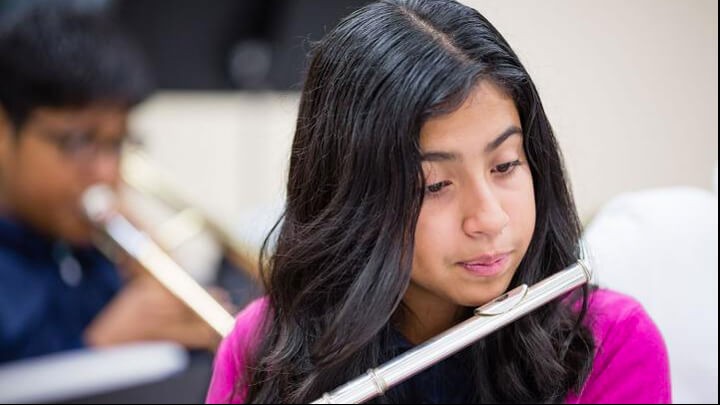Consider this: as we race willy-nilly through adulthood, today’s five year old children are right behind us; they’ll reach retirement age in 2070. If you’re like me, you have little time to consider what our global human society will truly be like so long from now – yet our actions today will absolutely shape our children’s well-being, productivity and life experiences. So it is our responsibility and privilege to help young people prepare today for their future success in work and life.
Music education engages and inspires us at any age, builds critical thinking, and supports cognitive and emotional strength. As society moves ever-faster, we know that discipline and flexibility, self-expression and group process are just a few of the “warp and weft” skills gained through music and arts education – in fact they may actually be critical to our survival. How do we act now, today, to keep music education strong for our children’s sake?
Because education decisions that impact our children truly are made at the local and state levels, we all have the power to help determine the amount of arts instruction time offered in our districts. School officials respond to their constituents’ viewpoints, particularly if advocates are well informed and focused on the needs of children.
What Can Concerned Parents Do?
Arts supporters have learned valuable lessons along the way to restoring and sustaining quality music and arts programs.
If you’re not sure where to begin, try one of these ‘top ten tactics’ they’ve offered up from experience:
1. Keep conversations focused on the needs of the children.
2. Call a meeting and create a local coalition of concerned parents, business and civic leaders.
3. Get comfortable with the language of school budgets; learn how decisions are made.
4. Attend a school board meeting and verbalize your support for arts education in your community.
5. Align with other arts and civic organizations that support your mission – get new groups involved and let the leaders emerge.
6. Write letters to the editor of your local newspaper outlining the benefits of school music and arts education.
7. Publicly celebrate the success and popularity of your school music and arts programs. Invite the local media to a school art exhibit, dance, or music performance and use this time to educate reporters on local budget issues.
8. Identify state legislative initiatives that affect your programs. Visit your congressional representatives and raise their awareness.
9. Be proactive. Track the timing of school budget decisions in your community, but make your case for arts education all year. Stay positive and in consensus-building mode; do your homework together and become known as part of the solution to building a better community.
10. Roll up your sleeves, download the SupportMusic Community Action Kit and get to work with the tools and techniques it provides. This free resource offers concrete ways to help you advocate for a complete education that includes music instruction for every child.
As an educator and a national advocate for music education, I have a professional imperative to defend every child’s right to a complete education that includes music, the arts and the other core academic subjects. As a public school parent whose own child received a strong music and arts education, my personal motivation to support student access to the arts grows stronger by the day. I know that you join me in wanting the best for all our students’ future: pick one bullet above and get started. And by the way – if you haven’t yet picked up a musical instrument but have always wanted to try, I promise it is never to late to learn. Think about it… and contact us at info@nammfoundation.org if you Wanna Play!
-- Sandra Kilpatrick Jordan is the parent of a public school graduate (Portions of this article were originally published in the August/September 2007 issue of the National PTA’s magazine, “Our Children”.)

